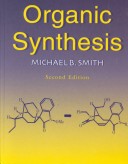McGraw-Hill International Editions
1 total work
Written for a graduate or possibly senior level first organic course in synthesis/reactions for students in chemistry, medicinal chemistry, or pharmacy, "Organic Synthesis" provides in one text a review of basic techniques and tools of organic chemistry as well as a thorough introduction to the synthesis process. The focus of the book is on familiarizing the student with the reactions necessary for synthesis, identifying and developing the strategies and methods of doing synthesis as well as developing the mental processes which must be used in planning and executing a synthesis, and then doing the synthesis. The text includes a unique chapter containing total synthesis done by students along with instructor commentaries as examples of approaches and potential pitfalls to synthesis. Written so that chapters may be used independently for maximum flexibility, the text has two major parts: chapters 2-7 cover functional and protecting groups and chapters 8-9, 11-13 cover carbon bonds. Chapter 1 introduces three fundamental themes found in modern synthetic organic chemistry that are used throughout the text: disconnection, stereochemistry and conformation control.
Chapters 2-5 provide a review of the basic principles and tools of organic chemistry with a focus on those reaction types necessary for synthesis, while chapter 6 describes stereochemistry and conformation as applied to organic synthesis. Chapter 10 provides a novel approach to teaching synthesis. Coming after the student has had some introduction to synthesis processes and developed some tools (Chapters 8-9), it provides the student with an overview of the various strategies and ways of doing syntheses, rather than have the student simply read or work through a list of synthesis after synthesis. Chapter 14 contains several total syntheses done by students, along with instructor commentary, as examples of approaches and potential pitfalls. Approximately 40 class-tested and evaluated homework problems accompany each chapter, many with references in the literature to actual experiments.
Chapters 2-5 provide a review of the basic principles and tools of organic chemistry with a focus on those reaction types necessary for synthesis, while chapter 6 describes stereochemistry and conformation as applied to organic synthesis. Chapter 10 provides a novel approach to teaching synthesis. Coming after the student has had some introduction to synthesis processes and developed some tools (Chapters 8-9), it provides the student with an overview of the various strategies and ways of doing syntheses, rather than have the student simply read or work through a list of synthesis after synthesis. Chapter 14 contains several total syntheses done by students, along with instructor commentary, as examples of approaches and potential pitfalls. Approximately 40 class-tested and evaluated homework problems accompany each chapter, many with references in the literature to actual experiments.
